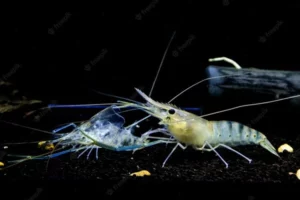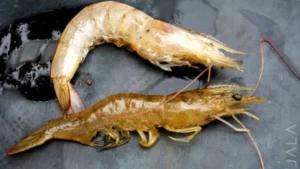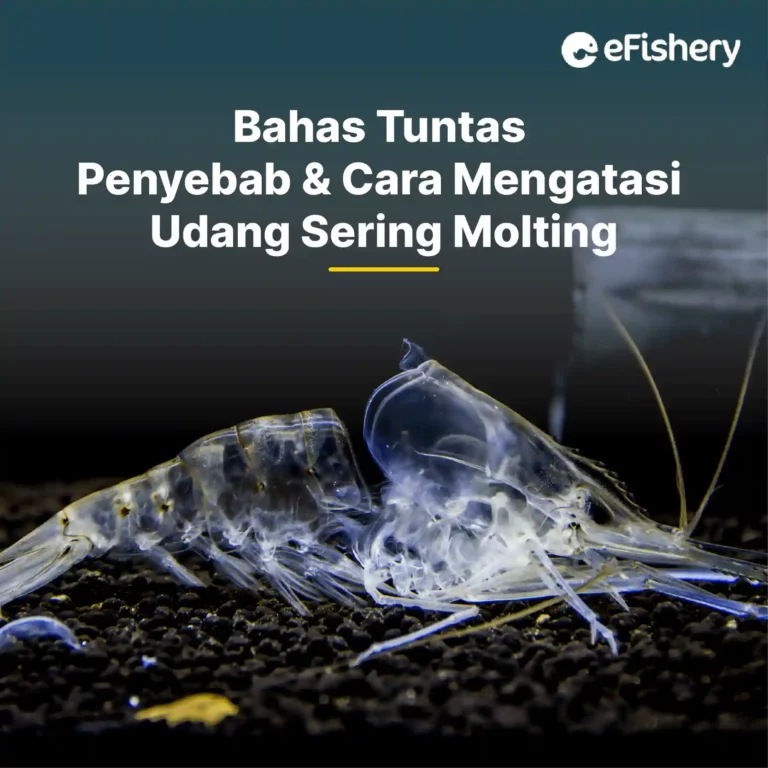Artikel Ini Telah Direview Oleh:

Anggie Nur
Magister Bioteknologi
Have you ever experienced molting shrimp? During the molting season or molting season, shrimp are very susceptible to disease. However, this stage is an important phase and always occurs in shrimp farming.
Usually, the molting process in shrimp occurs every 3-8 weeks during the spawning or laying period. In addition, shrimp that are exposed to severe stress will experience molting as a way of defending themselves. Therefore, you must be swift in dealing with it.
Let's discuss thoroughly the causes and ways to deal with frequent molting shrimp so that your cultivation can be carried out properly and safely, so you don't have to worry and be confused anymore if you are in a condition like this.
What is Molting?
Molting in shrimp is the process of changing the shell or shrimp shell. Molting is a natural process in shrimp life. Shrimp shell type is hard and stiff, so skin changes will occur as the shrimp ages.
In the larval stage, molting occurs every 30-40 hours at 28℃. While in the juvenile stage, the shrimp molt every 4-6 days with an ABW of 1-5 grams of shrimp weight. Then, when the ABW of the shrimp reaches 15 grams, the molting period occurs once every 2 weeks.
Shrimp molting depends on the speed of growth and the process doesn't take long. Molting occurs when the shrimp experiences an increase in body volume, while the size of the exoskeleton does not increase due to its rigid nature.
When the shrimp experience growth, the shrimp meat will fill the exoskeleton, so that the molting process occurs to grow a larger exoskeleton. The larger the size of the shrimp will make the molting time longer. This is because the shrimp will tend to be self-satisfied and use the protein in their bodies to form a new exoskeleton within a few hours.
During the full moon, farmers are usually worried about the shrimp they are cultivating because during this phase the shrimp will change their skin. According to research by Rusaini and Owens (2019), the molting process varies quite a lot in every full moon, where the highest molting occurs during the new moon phase (newmoon) of 36,96%.
The molting process is very risky, where shrimp are very vulnerable to disease and cannibalism from other shrimp because they are very weak. In addition, some shrimp are unable to survive changes in water quality, especially in maintaining their body's osmotic pressure.
If left unchecked, it will happen osmotic shock in the form of excess water absorption in the shrimp body cells. Therefore, you need to maintain the condition of the molting shrimp so that mass molting does not occur.
Causes of Shrimp Often Molting
There are several factors why shrimp molt more often than normal. These factors are as follows:
1. Environmental Conditions
An unstable environment can cause stress to the shrimp and cause the shrimp to molt frequently. Water quality parameters that cause this are temperature, salinity, DO, and pH. If one, some, or all of these parameters are disturbed and are outside normal limits, the shrimp will experience stress and molt more frequently.
The optimum temperature for raising shrimp in ponds is 25-30℃. Optimal water salinity for shrimp to live and grow well is in the range of 30-31 ppt.
Meanwhile, a good DO value for shrimp is > 3 mg/L. Last but not least, the optimal water pH for shrimp growth is around 7.5-8. You need to pay attention to the pH of pond water because it greatly affects the metabolism and physiological processes of shrimp.
2. Effect of Feed
Feed has a major influence on the growth phase of shrimp. Feed that does not contain enough nutrients can cause health problems in shrimp and inhibit the molting process.
3. Shrimp Age
Juvenile shrimp molt more often than adults because young shrimp are still growing. The frequency of skin changes in young shrimp is once every 1-2 weeks. The process of changing the skin on young shrimp will completely replace the carapace on the shrimp body, so that the meat inside will be easier to grow.
4. Stress in Shrimp
The factor that causes shrimp to molt frequently is stress. In addition to the environmental factors mentioned above, stress on shrimp can also be caused by overpopulation in ponds. This can lead to competition for feed and space, causing health problems in shrimp and inhibiting the molting process.
Shrimp can also experience stress due to handling (handling) and other environmental factors, such as disease and water pressure or currents.

Impact of Shrimp Often Molting
Molting occurs as a result of hormonal processes in the body of the shrimp. In cases that are often found, the molting process usually occurs when the shrimp spawn.
You need to know, the molting cycle can be disrupted due to the significant stress that occurs in the shrimp. For example, due to maintenance ponds that are drained too often. This can inhibit the process of spawning shrimp and trigger molting in shrimp.
Basically, the process of molting that often occurs can disturb the balance of the shrimp body. The most vulnerable phase is when the shell is just starting to form on post-molting, karena pada dasarnya, fase ini mengganggu keseimbangan tubuh udang secara signifikan.
When molting, shrimp can also be attacked by several diseases. For example disease White Spot Syndrome (WSS) which usually appears in stages A and B of the phase post-molting or the recovery phase from a previous molt. Phase A phase post-molting is the phase when the shrimp absorbs a lot of water (stage A) in order to be able to grow and strengthen new cuticles. The shell that will appear according to the size of the new body will harden within a few hours (stage B).
Apart from being susceptible to disease, shrimp are also susceptible to exposure osmotic shock caused by the absorption of water that is quite a lot in the body of the shrimp. This process will greatly affect the condition of cells in the shrimp body, especially in cell functions that are disrupted due to changes in water content. This can cause stress, even death in shrimp.
How to Deal with Often Molting Shrimp
In shrimp farming, you need to know the right way to deal with shrimp that often molt. The following are tips for anticipating threats when shrimp molt.

1. Reduce the Frequency and Volume of Pond Water Change
When the shrimp molt, you need to avoid things that worsen the condition of the shrimp. One way is to reduce the frequency and volume of water changes. The recommended water change volume is 10% of the pond water volume. In the case of ponds with high ammonia, you need to do a water change of 20-50% from the volume of pond water.
Water change is recommended gradually or gradually to anticipate stress on the shrimp and mass death of plankton. In addition, if you see that the brightness level of the pond water is not stable in the pond, you should immediately apply fertilization so that the water brightness returns to stability.
2. Daily Feed Adjustments
When the shrimp have no appetite, you can reduce the amount of feed given at each daily feed frequency. The goal is not to happen overfeeding which resulted in the bottom of the pond accumulating leftover feed that was not eaten by the shrimp. But keep in mind, you should not reduce the frequency of feeding, because it can lead to cannibalism.
3. Checking the Pond Water Drainage
You need to carry out intensive checks on pond water drainage, with the aim of monitoring the development of the condition and quality of the shrimp when mass molting occurs. If you find dead shrimp that were carried out during the pond water disposal process, immediately check the bottom of the pond to find out the level of the problem that has occurred. If you see that the condition of the shrimp population has indicated that it is experiencing serious problems, it is best to harvest early so as not to cause big losses.
4. Checking the Condition of Ponds
You need to make efforts so that the shrimp can molt well. The trick is to maintain ideal water environmental conditions, especially the dissolved oxygen (DO) content, alkalinity, and pH.
5. Provision of Supplements
Providing supplements to shrimp is beneficial for increasing the process of forming and regulating molting, helping to increase and maintain the alkalinity and pH of pond water, and precipitating suspended solids.
Atasi Udang Sering Molting dengan Konsultasi Budidaya di eFarm!
Need Help Regarding Shrimp Cultivation Business?
Fill in your personal data in the following form. Our team will immediately contact you via the number cellphone attached. Make sure the data entered is correct.
Itu dia beberapa informasi terkait permasalahan udang sering molting. Jika Bapak/Ibu ingin langsung berkonsultasi dan mendapatkan rekomendasi terkait pengelolaan yang tepat untuk molting udang, Bapak/Ibu bisa langsung mengakses fitur Cultivation Consultation in app eFarm secara GRATIS. Bapak/Ibu akan berkonsultasi langsung dengan Ahli Budidaya eFishery dan mengetahui tips menarik lainnya seputar budidaya udang.
Fill out the form above to consult at Cultivation Consultation secara FREE!

Anggie Nur - Magister Bioteknologi
Anggie merupakan lulusan sarjana dan magister bioteknologi serta memiliki pengalaman riset di dunia perikanan khususnya udang
Questions About the Causes and Ways to Overcome Shrimp Molting Often
Young shrimp change their skin more often due to age in shrimp. This process will completely replace the carapace of the shrimp body so that the flesh inside will grow more easily.
The way to deal with shrimp that often molt is to reduce the frequency and volume of pond water changes, make daily feed adjustments, check pond drainage, monitor pond conditions, and provide supplements.
- Ali and Waluyo. 2015. Survival and Growth Rate of Giant Prawns (Macrobrachium rosenbergii De Man) on Media Bsalinity. Limnotek 22(1): 42-51
- FPIK UNPAD. 2021. Why Should We Be Cautious When Lobsters Molt?
- Muzahar. 2020. Shrimp Culture Technology and Management. UMRAH PRESS
- Rusaini and Owens. 2019. The Effect of Viral Infection on The Relationship between The LOS Cells and Moulting Stages of The Black Tiger Parwn (Panaeus monodon). AACL Bioflux. 12(4): 1087:1101
- https://app.jala.tech/kabar_udang/bulan-purnama-dan-molting-udang
- https://www.minapoli.com/info/tahap-molting-pada-udang
- https://nanobubble.id/blog/proses-udang-molting
